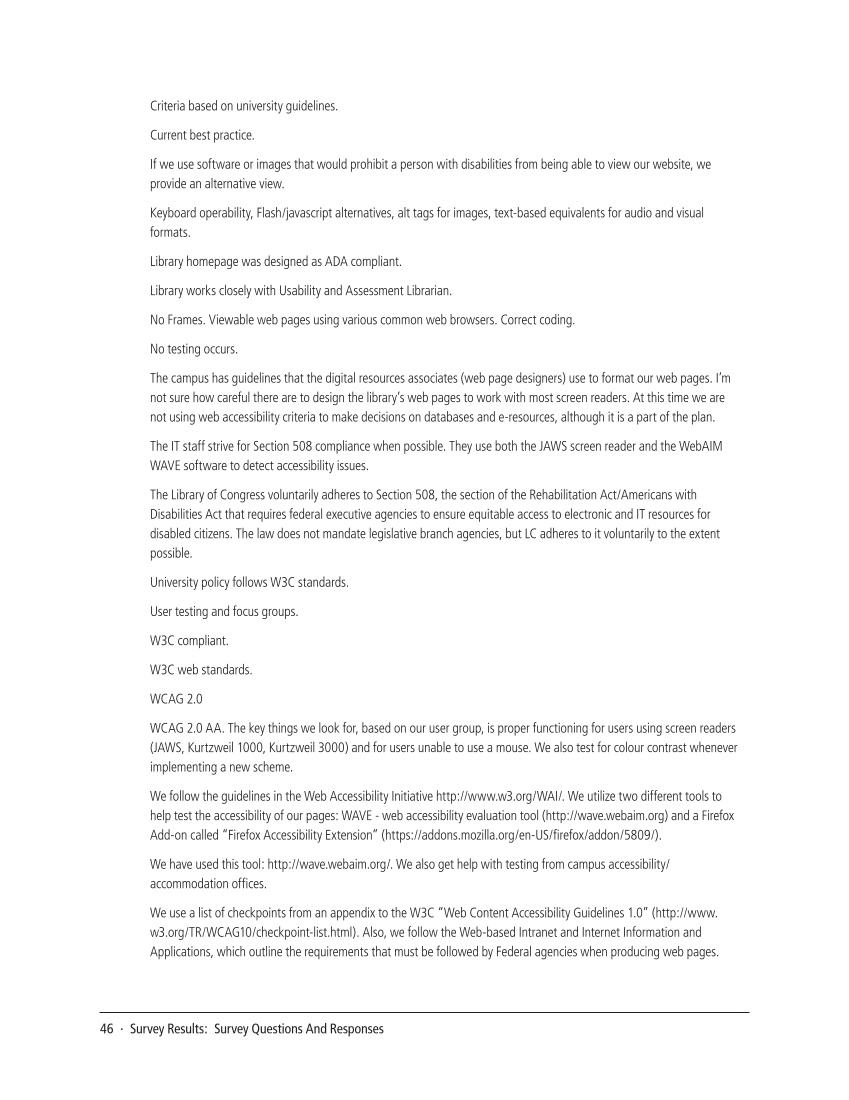46 · Survey Results: Survey Questions And Responses
Criteria based on university guidelines.
Current best practice.
If we use software or images that would prohibit a person with disabilities from being able to view our website, we
provide an alternative view.
Keyboard operability, Flash/javascript alternatives, alt tags for images, text-based equivalents for audio and visual
formats.
Library homepage was designed as ADA compliant.
Library works closely with Usability and Assessment Librarian.
No Frames. Viewable web pages using various common web browsers. Correct coding.
No testing occurs.
The campus has guidelines that the digital resources associates (web page designers) use to format our web pages. I’m
not sure how careful there are to design the library’s web pages to work with most screen readers. At this time we are
not using web accessibility criteria to make decisions on databases and e-resources, although it is a part of the plan.
The IT staff strive for Section 508 compliance when possible. They use both the JAWS screen reader and the WebAIM
WAVE software to detect accessibility issues.
The Library of Congress voluntarily adheres to Section 508, the section of the Rehabilitation Act/Americans with
Disabilities Act that requires federal executive agencies to ensure equitable access to electronic and IT resources for
disabled citizens. The law does not mandate legislative branch agencies, but LC adheres to it voluntarily to the extent
possible.
University policy follows W3C standards.
User testing and focus groups.
W3C compliant.
W3C web standards.
WCAG 2.0
WCAG 2.0 AA. The key things we look for, based on our user group, is proper functioning for users using screen readers
(JAWS, Kurtzweil 1000, Kurtzweil 3000) and for users unable to use a mouse. We also test for colour contrast whenever
implementing a new scheme.
We follow the guidelines in the Web Accessibility Initiative http://www.w3.org/WAI/. We utilize two different tools to
help test the accessibility of our pages: WAVE -web accessibility evaluation tool (http://wave.webaim.org) and a Firefox
Add-on called “Firefox Accessibility Extension” (https://addons.mozilla.org/en-US/firefox/addon/5809/).
We have used this tool: http://wave.webaim.org/. We also get help with testing from campus accessibility/
accommodation offices.
We use a list of checkpoints from an appendix to the W3C “Web Content Accessibility Guidelines 1.0” (http://www.
w3.org/TR/WCAG10/checkpoint-list.html). Also, we follow the Web-based Intranet and Internet Information and
Applications, which outline the requirements that must be followed by Federal agencies when producing web pages.
Criteria based on university guidelines.
Current best practice.
If we use software or images that would prohibit a person with disabilities from being able to view our website, we
provide an alternative view.
Keyboard operability, Flash/javascript alternatives, alt tags for images, text-based equivalents for audio and visual
formats.
Library homepage was designed as ADA compliant.
Library works closely with Usability and Assessment Librarian.
No Frames. Viewable web pages using various common web browsers. Correct coding.
No testing occurs.
The campus has guidelines that the digital resources associates (web page designers) use to format our web pages. I’m
not sure how careful there are to design the library’s web pages to work with most screen readers. At this time we are
not using web accessibility criteria to make decisions on databases and e-resources, although it is a part of the plan.
The IT staff strive for Section 508 compliance when possible. They use both the JAWS screen reader and the WebAIM
WAVE software to detect accessibility issues.
The Library of Congress voluntarily adheres to Section 508, the section of the Rehabilitation Act/Americans with
Disabilities Act that requires federal executive agencies to ensure equitable access to electronic and IT resources for
disabled citizens. The law does not mandate legislative branch agencies, but LC adheres to it voluntarily to the extent
possible.
University policy follows W3C standards.
User testing and focus groups.
W3C compliant.
W3C web standards.
WCAG 2.0
WCAG 2.0 AA. The key things we look for, based on our user group, is proper functioning for users using screen readers
(JAWS, Kurtzweil 1000, Kurtzweil 3000) and for users unable to use a mouse. We also test for colour contrast whenever
implementing a new scheme.
We follow the guidelines in the Web Accessibility Initiative http://www.w3.org/WAI/. We utilize two different tools to
help test the accessibility of our pages: WAVE -web accessibility evaluation tool (http://wave.webaim.org) and a Firefox
Add-on called “Firefox Accessibility Extension” (https://addons.mozilla.org/en-US/firefox/addon/5809/).
We have used this tool: http://wave.webaim.org/. We also get help with testing from campus accessibility/
accommodation offices.
We use a list of checkpoints from an appendix to the W3C “Web Content Accessibility Guidelines 1.0” (http://www.
w3.org/TR/WCAG10/checkpoint-list.html). Also, we follow the Web-based Intranet and Internet Information and
Applications, which outline the requirements that must be followed by Federal agencies when producing web pages.




































































































































































































